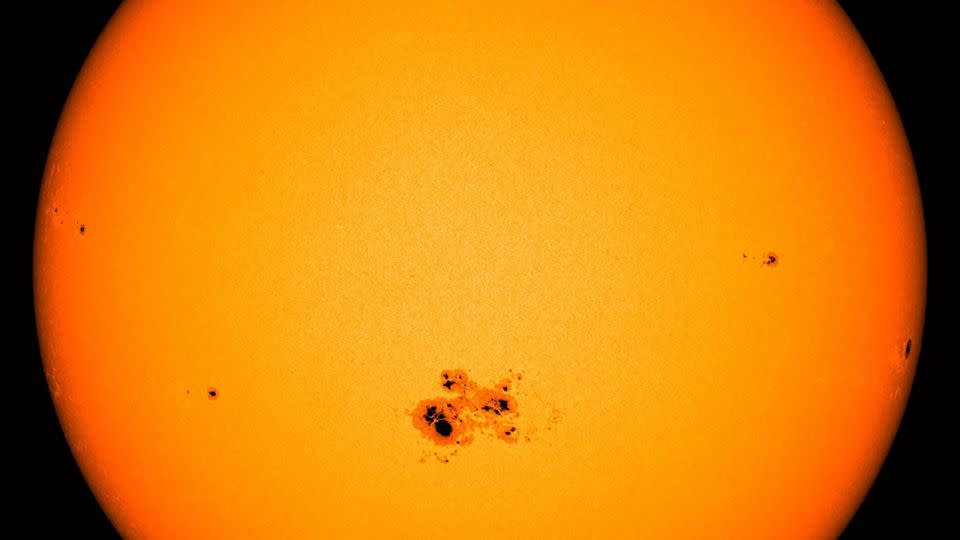Sign up for CNN’s Wonder Theory science newsletter. Explore the universe with news about fascinating discoveries, scientific developments and more.
In 1607, German astronomer Johannes Kepler sketched sunspots based on his observations of the sun’s surface. Centuries later, the groundbreaking drawings are helping scientists solve a solar mystery.
Although everything in the solar system revolves around the Sun, scientists have yet to unravel many of the star’s secrets.
However, by studying the Sun’s variability over time, including the solar cycle, we can answer some of the most long-standing questions about the fiery orb and how it changes.
Some of these questions relate to solar activity in the 17th century, a period of crucial importance for the study of the Sun.
Astronomers first observed sunspots with telescopes in 1610. At the same time, the sun was undergoing an unusual transition to an extended period of weakened activity. And Kepler’s long-ignored sketches, overlooked because they were drawings rather than telescopic observations, could provide crucial historical insights.
A new study that recreates the conditions under which Kepler made his drawings was published July 25 in The Astrophysical Journal Letters.
“Kepler set many historical benchmarks in astronomy and physics in the 17th century, and left its legacy even in the Space Age,” lead researcher Hisashi Hayakawa, an assistant professor at Nagoya University’s Institute for Space-Earth Environmental Research, said in a statement.
“Here we add to this by showing that Kepler’s sunspot records predate the existing telescopic sunspot records of 1610 by several years. His sketches of sunspots serve as evidence of his scientific acumen and perseverance in the face of technological limitations.”
The Sun’s tumultuous activity
The sun experiences an 11-year cycle of waxing and waning activity, known as the solar cycle. Currently, scientists believe the sun is at or nearing solar maximum, the annual peak of its activity for the current solar cycle, called solar cycle 25.
Solar maximum is typically associated with an increase in the number of sunspots visible on the sun’s surface. These dark areas, some of which can be as large as Earth or larger, are driven by the sun’s strong and constantly changing magnetic fields.
Today, scientists track solar activity using data from Earth-based and space-based observatories, magnetic maps of the sun’s surface, and ultraviolet observations of the sun’s outer atmosphere.

But centuries ago, observing the sun was already quite a challenge.
Sunspots were spotted with the naked eye through fog, haze, smoke from wildfires or near sunrise or sunset, when the atmosphere helped dim the sun’s brightness, said Mark Miesch, a researcher at the National Oceanic and Atmospheric Administration’s Space Weather Prediction Center in Boulder, Colorado. Miesch was not involved in the new research.
Kepler used a device called a camera obscura, which used a small hole in the wall of the instrument to project the image of the Sun onto a sheet of paper and sketch the features he observed. Kepler mistakenly thought he had captured Mercury as it orbited the Sun in May 1607, but he retracted his report 11 years later and determined that he had observed a group of sunspots.
“Because this report was not a telescopic observation, it has only been discussed in the context of the history of science and has not been used for quantitative analyses of solar cycles in the 17th century,” Hayakawa said.
“But this is the oldest sketch of a sunspot ever made with an instrumental observation and a projection. We realized that this drawing of a sunspot should be able to tell us the location of the sunspot and indicate the phase of the solar cycle in 1607, as long as we could constrain the observation point and time and reconstruct the tilt of the heliographic coordinates — meaning the positions of features on the surface of the Sun — at that point in time.”
A grand solar minimum
Sunspots aren’t the only way scientists can understand changes in the sun. Variations in the sun’s magnetic field regulate the movement of high-energy particles called cosmic rays through space, Miesch said.
When cosmic rays hit the Earth’s atmosphere, they can change its chemical composition, including the carbon balance.
“Over time, this carbon is incorporated into plants and animals, even ourselves,” Miesch said. “Tree rings offer a unique opportunity to trace the change in carbon from one year to the next. Some rings in old trees can be traced back thousands of years. Isotopes of carbon and other elements can similarly be traced via air bubbles trapped in glacial ice cores.”
The carbon isotopes trapped in tree rings and ice cores have been used to put ancient sunspot observations into context and increase our understanding of solar activity before sunspot observations were made, Miesch said.
Such data have been used to help astronomers understand the Maunder Minimum, a period of extremely weak and abnormal solar cycles between 1645 and 1715. During this so-called grand solar minimum, sunspots virtually disappeared, and the few that were observed appeared only in the southern hemisphere. The background mechanism of the grand solar minimum is still debated by astronomers, especially as they try to figure out when and if it might occur in future centuries.
Astronomers agree that the pattern of solar activity gradually shifted from regular cycles to the grand minimum.
Previous analysis of tree rings showed that a short solar cycle, solar cycle minus 14, lasted only about five years, leading to an extremely long solar cycle of 16 years, known as solar cycle minus 13.
“If that is true, that would indeed be interesting,” Hayakawa said. “But another tree-ring-based reconstruction indicated a series of solar cycles with normal duration (11 years). So which reconstruction should we trust? It is very important to check these reconstructions with independent — preferably observational — data.”
So he turned to Kepler’s sketches.


Hayakawa and his colleagues translated Kepler’s original report, written in Latin, to understand the precise orientation of his sunspot sketches and to constrain the time period and locations over which Kepler made the observations.
Hayakawa then visited several sites in Prague, including Kepler’s residence at the French Crown and the workshop of court mechanic Justus Burgi, to gain a better understanding of the topography from which Kepler saw the sunspots.
Modern data tools allowed Hayakawa and his colleagues to calculate the tilt of the sunspot and determine its location on the Sun. They also applied Spörer’s law, first observed by English amateur astronomer Richard Christopher Carrington but further developed by German astronomer Gustav Spörer, which described a migration of sunspots from high to low latitudes during a solar cycle.
The research team determined that the sunspot group observed by Kepler belonged to the end of the solar cycle minus 14, and not to the beginning of the solar cycle minus 13.
The findings support the idea that Solar Cycle minus 13 had a normal duration of 11 years instead of 16 years. The researchers were also able to estimate that Solar Cycle minus 13 likely began between 1607 and 1610.
“This shows a typical transition from the previous solar cycle to the next cycle, consistent with Spörer’s law,” study co-author Thomas Teague, an observer at the Solar Influences Data Analysis Center at the Royal Observatory of Belgium, said in a statement.
Since the longest solar cycle ever measured in the past three centuries lasted 14 years, it’s time to find another scientific precursor to the Maunder Minimum, Hayakawa said.
Kepler’s Lasting Legacy
There is still much to learn from historical figures like Kepler, says study co-author Sabrina Bechet, a researcher at the Royal Observatory of Belgium.
“As one of my colleagues told me, it’s fascinating to see that the legacies of historical figures convey crucial scientific implications to modern scientists, even centuries later,” Bechet said. “In the case of Kepler, we stand on the shoulders of a scientific giant.”
Hayakawa says Kepler’s sketches contribute to ongoing debates about the solar cycles that led to the Maunder Minimum, and can help astronomers model the conditions leading up to the event.
“By placing the Kepler findings within broader reconstructions of solar activity, scientists gain crucial context for interpreting changes in the Sun’s behavior during this crucial period that marks the transition from regular solar cycles to the grand solar minimum,” he said.
Miesch called the new study an “impressive piece of work” and an example of detective work that gleans new insights from historical documents.
“The long history of sunspot observations provides a link through the ages to generations of astronomers who have viewed the Sun with reverence and curiosity, evolving from superstition to scientific inquiry to understanding. It is inspiring to see that astronomers of the past continue to contribute to scientific discovery. And their efforts are more important now than they could ever have imagined, as our technological society becomes increasingly vulnerable to the timeless ebb and flow of solar activity.”
For more CNN news and newsletters, create an account at CNN.com